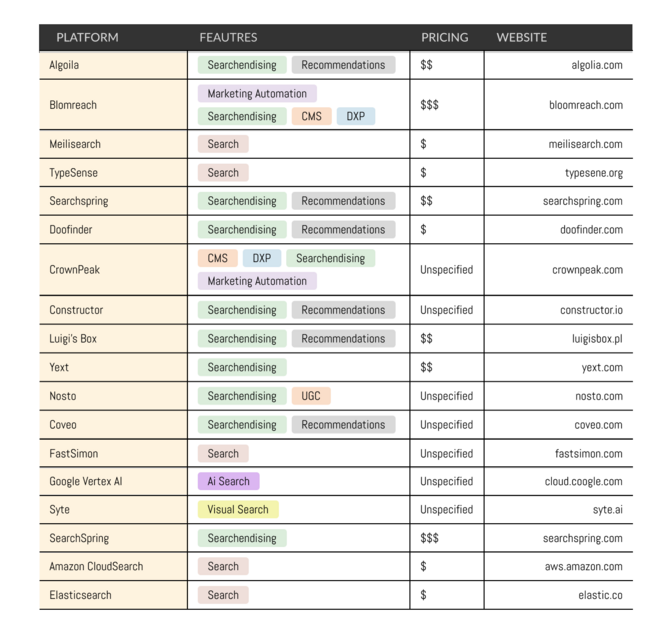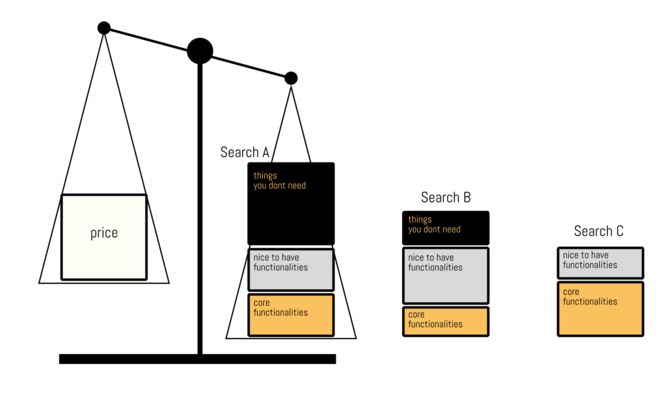How to Choose the Ideal Search as a Service in E-Commerce?
Social media notifications, live chats, dozens of browser tabs... With so many alluring online activities, it’s easy to understand why shoppers don’t want to waste time. Case in point: 70% of customers jump straight to the search bar when they enter e-commerce sites.
This highlights the critical importance of e-commerce search functionality in today's digital marketplace.
Still, many of these same e-commerce sites deliver a poor search experience, failing to direct the customer to the correct items and thus losing potential sales. To create a comfortable (and profitable) experience, Search as a Service (SaaS) is often an exciting option, especially when it comes to implementing personalized search capabilities.
In this blog post, we'll explore the key factors to consider when choosing the ideal Search-as-a-Service solution, ensuring you can provide your customers with a seamless and efficient search experience.
What is Search as a Service?
At its core, Search as a Service refers to using a third-party, cloud-based search platform that can be easily integrated into an e-commerce website or application. It's an efficient way to perform site search optimization and implement personalized search features.
Rather than building and maintaining your search infrastructure, you can leverage the capabilities of a specialized search provider to power your customers' search experience. This approach allows for the implementation of advanced features like intelligent search and search personalization techniques.
How Search as a Service Typically Works?
First, you provide the SaaS provider with your data, such as website content, product catalogs, documents, and application data.
The provider may offer API access, data connectors, or manual upload tools to facilitate the data integration. Some SaaS providers even have web crawlers that can automatically crawl and index your website's content.
They then use advanced search algorithms to index the data, making it organized and easy to search. Advanced techniques like Natural Language Processing (NLP), AI-powered search, synonym detection, and entity recognition are common to automatically make sense of the data.
Now that the SaaS has the data indexed, you can use the provider's search API to power up your e-commerce search backend with different parameters and filters. This enables personalized search results based on user data analysis and browsing behavior.
The frontend layer is separate and has to be designed according to your website's visual identity. As a plus, some vendors offer helpful search pre-built search boxes, filters, and other UI components to speed up the process.
When customers search on your e-commerce site, their query is sent to the Search as a Service platform rather than processed by your servers.

SaaS platforms typically offer analytics and reporting tools to track search performance and user behavior. These insights allow you to fine-tune the search features and constantly optimize the customer journey.
A Note on Data Privacy
An important privacy point is that SaaS platforms don’t receive personally identifiable information from users performing queries.
Platforms must collect user action data to provide and improve search recommendations. However, they obtain user search terms and access tokens, maintaining user anonymity.
This practice makes complying with CCPA, GDPR, and other relevant regulations easier.

Recommendations often go hand in hand with search implementation. To implement these recommendations effectively, we need to collect information about user actions, commonly called user events.
Recommendations can be generated anonymously, based on a user's current session, or non-anonymously, by collecting information from multiple sessions. This approach allows for both content-based filtering and collaborative filtering methods in personalized search implementation.
It's important to note that we never send sensitive user data to third-party services. Instead, we use a token that represents the user. This approach ensures user privacy while enabling personalized and relevant recommendations.
How Search as a Service Can Revamp the E-Commerce's Search Engine
E-commerce search has some unique requirements compared to other industries.
As mentioned before, customers want to find and purchase specific products in an online store. The search function must be highly accurate and tailored to the user's intent, offering personalized search results.
This time pressure differs from a general web search (think Google), which aims to provide the most relevant information on various topics.
Another key difference is the importance of product metadata. In e-commerce, detailed information about each product, such as descriptions, categories, and attributes, is crucial for powering an effective search experience.
This structured data allows the search engine to understand the products better and match them to customer queries.
5 Benefits of Search as a Service in E-Commerce
When it comes to potential benefits, Search as a Service can be particularly helpful in e-commerce:
- Increased scalability and reliability - Search as a service providers are designed to scale seamlessly, ensuring that your search functionality can handle spikes in traffic and an expanding product catalog.
- Reduced maintenance and IT overhead - SaaS offloads the technical complexities of search, such as managing servers, optimizing indexing, and fine-tuning relevance algorithms.
- Flexibility and customization - SaaS usually allows for quick customization of many search aspects, from functionality to visuals, without hard-coding every change. This includes implementing personalized search features and voice search capabilities.
- Market insights - Search as a Service platforms often have access to a wealth of data and insights from the market that can enhance the search experience. For example, the provider may analyze search patterns and user behavior across their customer base to fine-tune your search features.
- Bottom-line impact - at the end of the day, better and more performant search features deliver increased customer satisfaction, higher engagement, and, ultimately, more conversions. Personalized search in e-commerce can significantly boost click-through rates and average order value.
But Why Not Improve Search In-House?
Revamping the e-commerce search in-house should always be the first option. But there are cases when it’s not the best alternative.
First of all, time and know-how. Search providers focus on delivering top search features – that’s their business goal. Integrating these features instead of developing from scratch means saving time in development and research.
The integration raises valid concerns: Isn’t it too complex or costly? Fortunately, the Search-as-a-Service market has matured in recent years, with many vendors offering flexible, cost-effective solutions with different pricing options.
The mature Search-as-a-Service market means shallow risk when testing different integrations and implementations, including personalized search implementation and other search personalization techniques.
Features of Search Engines in E-Commerce
Let’s talk about features that make customers love search – these are the ones you should look for in your SaaS research.
While some of these features may overlap, each contributes to creating a seamless, intuitive, and engaging search experience that can increase conversions and customer loyalty.
Product ranking
The search engine analyzes ranking factors like product attributes, customer behavior, and search intent to surface the most relevant products based on the customer's query.
Example: When the customer searches for "iPhone 15", the search engine analyzes factors like the phone's specifications, customer reviews, and purchase history to display the most relevant iPhone 15 models at the top of the results.
Suggestions and Recommendations
The search engine provides dynamic suggestions and product recommendations based on the customer's query and browsing history, helping them discover new items.
These relevant search results can help customers discover new items they may not have otherwise found, driving increased engagement and sales.
Example: When the customer types "iPhone 15," the search engine provides suggestions like "iPhone 15 Pro," "iPhone 15 Plus," and "iPhone 15 accessories." Based on the customer's browsing history, it also recommends related products, such as iPhone cases and chargers.
Personalized Results
The search engine can deliver personalized search results and tailored recommendations by integrating with the customer's account, search history, and location.
It might include tailored search results, customized product rankings, and specialized recommendations that cater to the individual's preferences and shopping habits.
Example: If the customer is logged in, the search engine uses their previous purchase data, past searches, and location to suggest the iPhone 15 model and storage capacity that best fits their needs.
Autocomplete
The search engine provides relevant query suggestions as the customer types, saving time and helping customers refine their searches and discover products they may not have initially considered. A good reference is Google Search's suggestions.
Example: When the customer starts typing "iPhone 15", the search engine autocompletes the query with suggestions like "iPhone 15 128GB" or "iPhone 15 Pro Max".
Search Listing Page
A dedicated results page with an intuitive layout showing product details like images, pricing, reviews, and sorting and filtering options.
Example: The search results page for "iPhone 15" displays product images, prices, customer ratings, and options to filter by storage capacity, color, and carrier compatibility.
Semantic Search
With semantic search, the search engine understands natural language queries and allows customers to narrow down results using detailed filters.
Natural language processing is a powerful tool to provide personalized experiences and more relevant results.
Example: The customer can use natural language queries like "iPhone 15 with 256GB storage and blue color", and the search engine will surface relevant results.
Faceted Search
Enables customers to explore and refine their results by dynamically applying multiple filters.
This can be particularly useful for e-commerce sites with large, complex product catalogs, as it helps customers quickly identify the items they're looking for.
Example: If the customer is unsure of the specific iPhone 15 model they want, they can use the faceted search to explore and refine the results by factors like screen size, camera features, and price range.
Result Preview
Providing customers with the ability to preview product details, such as images, descriptions, and reviews, directly from the search results page can enhance the overall search experience and reduce the number of clicks required to make a purchase decision.
Example: From the search results page, customers can preview details about each iPhone 15 model, such as the product description, technical specifications, and customer reviews.
Searchandising
Curated search results are a feature that promotes specific products, collections, or content based on search queries.
It has numerous benefits since it highlights chosen products with lightning-fast results, increasing conversion rates.
Example: When the customer searches for a “smartphone,” the website recommends the iPhone 15, helping the customer discover the latest offers and deals.
Visual Search
Enables customers to upload images and find visually similar products in the catalog. This can be particularly useful for fashion and home decor retailers.
Example: If the customer has a specific iPhone 15 color in mind, they can upload an image to the search engine and find visually similar models available on the site.
Incorporating these features into your e-commerce through a Search as a Service platform can help you deliver a truly exceptional search experience that not only delights your customers but also drives increased engagement, conversions, and revenue for your business.
The Best Search as a Service Engines to Improve E-Commerce Search Results
With all considerations out of the way, let’s cover the best options of Search-as-Service providers.

How to Choose the Ideal Search as a Service Platform?
When selecting the ideal Search as a Service solution for your e-commerce business, consider these key factors:
- Assess your requirements. Clearly define your needs, whether handling an extensive product catalog, integrating with your platform, or supporting multiple languages. In particular, consider if you need a bare-bones SaaS offering or something more comprehensive, such as a Digital Experience Platform (DXP), where search is only a fraction of the product.
- Evaluate customization and flexibility. Look for solutions that offer a high degree of customization and the ability to adapt as your business evolves. This includes the ability to implement personalized search and other advanced features like voice search or vector search.
- Consider scalability and performance. Ensure the SaaS provider can scale seamlessly to handle increased traffic and maintain fast, reliable search functionality.
- Consider pricing and deployment options. Evaluate the pricing structure and deployment models (cloud, on-premises, hybrid) to find the best fit for your budget and preferences.
- Simulate investment scenarios. Platforms often charge monthly based on usage (number of requests and records) on top of the base price. Be sure to simulate your average needs beforehand to avoid surprises.
- Prioritize ease of integration. Choose a solution with robust APIs and a straightforward implementation process to minimize disruption. This is especially important when implementing personalized search or other advanced features.
- Evaluate the provider's expertise. Prioritize vendors with deep e-commerce experience and a proven track record of successful search deployments.

Low Risk, High Reward: Adopting a Search as a Service Engine
It’s no secret that search is critical in e-commerce. But, optimizing the search experience to drive conversions can be technically challenging.
Fortunately, Search-as-a-Service integrations help with just that. They offload the technical considerations so you can focus on making customers happy.
Hopefully, we made the research more accessible. For more information on how to integrate SaaS with your e-commerce and implement personalized search, get in touch with us right away.